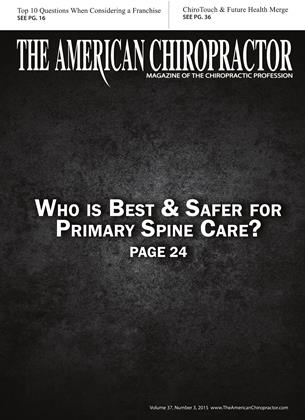Alar Ligament Laxity
TECHNIQUE
Dennis Woggon
A cervical strain occurs when muscles around the neck stretch or tear. A sprain occurs when the ligaments stretch or tear—ICD-9 code 847.0 and ICD-10 code S13.4XXA. The terms “cervical acceleration-deceleration injury” (CAD) or “whiplash” may also be used to describe the clinical findings of neck pain, particularly after a motor vehicle collision. CAD and whiplash are descriptive terms for neck pain; they do not represent specific diagnoses.
Ligament laxity is a cause of chronic body pain characterized by loose ligaments—ICD-9 code 728.4 and ICD-10 code M24.20. When this condition affects joints in the entire body, it is called generalized joint hypermobility, which occurs in about 5% of the population, and 30% of car crashes with T-bone-type or rotational motions. Anecdotal research in CLEAR Scoliosis Centers finds that approximately 98% of scoliosis patients have alar instability,1 and 95% of these cases can be related to birth trauma. In a study titled “Cervical Spinal Cord Injury in Children,”11 they examined 19 children under the age of 10 with a cervical spinal cord injury using clinical records and radiographs. Most of the children with a partial spinal cord injury were injured at birth. Many had no radiographic evidence of cervical fracture, and 88% percent developed scoliosis.
Ligament laxity is considered more serious than a sprain/ strain, and that is reflected in the ICD codes. Dr. Joel Franks is one of the few orthopedic surgeons who performs an upper cervical fusion for this alar instability. He states that surgery may be necessary with 3 mm or more of alar instability with associate severe headaches.m’lv
In other patients, clinical findings include:
• Headaches
• Dizziness • Confusion • Anxiety • Depression
• Mood swings (bi-polar)
Chronic pain, unstable neckv
This could also correlate with neurological impedance in this area affecting postural muscle control in development in scoliosis patients.
The upper cervical complex would exist between the occiput, atlas, and axis. It has both biomechanical and neurological components that can affect the health of the individual.
This must also be evaluated with the rest of the cervical spine and its closed kinetic chain environment.
A cross section of the spinal cord at the atlas level indicates ramifications with the spinocerebellar tracts, which relates to postural muscle control of the body.
The alar liga-
ment attaches from the dens of axis to the occiput.
The alar test is to have the patient face the doctor with the doctor’s hands on the patient’s shoulders. The patient is then instructed to look up and go as far into cervical extension as possible. Then the patient performs the same test with his or her eyes closed. Any deviation from an extension is a positive alai' test. A left head tilt would indicate right alar instability.
This would then be verified by AP open-mouth X-rays and then lateral flexion X-rays.
The lateral mass dens interval (LDMI) should be noted.
This would then be verified by AP open-mouth lateral flexion X-rays.
Digital motion X-ray is the best way to confirm this. The patient should tilt his or her head and neck laterally three times before the X-ray or during the DMX study to verify a lack of muscle guarding relative to the instability.
Due to the attachment of the alai' ligament from the axis to the occiput and the resultant instability of the atlas, manual adjusting or manipulation is contraindicated with these hypermobile ligament laxity areas.
INNOVATIONS
In this type of condition, an adjusting instrument, such as the ArthroStim, should be utilized based on the patient’s X-rays. The adjustment will be on the same side of alar instability as adjusting the opposite side would be adjusting into hypennobility.
References
z'. http:/ connection.ebscohost.com/c/case-studies/38334072/clearscoliosis-case-study 77. J Spinal Disord. 1992 777. http://w3. cns. org/dp/2012cns71436.pdf
iv. https ://www.youtube. com/watch ?v =spMkX3XA Wjs
v. “The Unstable Cervical Spine - Alar LigamentDamage”',
June, 2001, Canadian Chiropractor
Dr. Dennis Woggon is the founder of the CLEAR Scoliosis Institute and the St. Cloud Chiropractic Clinic. He graduated from Palmer College of Chiropractic in 1974. He is an international instructor for CLEAR Scoliosis Institute. He can be contacted at [email protected].
 View Full Issue
View Full Issue






